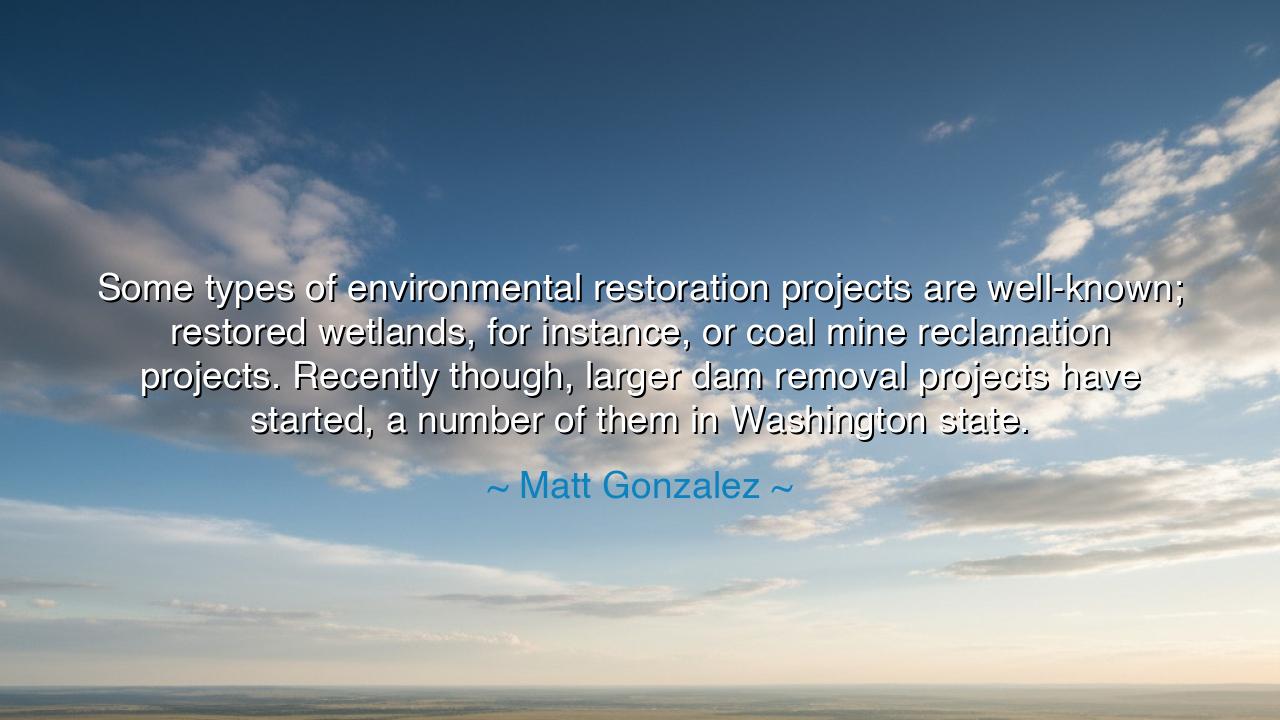
Some types of environmental restoration projects are well-known;
Some types of environmental restoration projects are well-known; restored wetlands, for instance, or coal mine reclamation projects. Recently though, larger dam removal projects have started, a number of them in Washington state.






When Matt Gonzalez said, “Some types of environmental restoration projects are well-known; restored wetlands, for instance, or coal mine reclamation projects. Recently though, larger dam removal projects have started, a number of them in Washington state,” he was bearing witness to one of the most profound transformations of the modern age — the healing of the Earth by human hands. His words mark a moment in time when humanity, long known for reshaping rivers and mountains for its own gain, began to reverse the tide, to return what was taken, and to restore balance to the living world. It is a quiet revolution, not fought with weapons or greed, but with compassion, humility, and the courage to undo centuries of harm.
The origin of this statement lies in the growing movement of environmental restoration, a discipline born from both regret and wisdom. For centuries, mankind sought to subdue nature — to drain its wetlands, to dig deep for coal, to build dams that chained mighty rivers into submission. These acts of domination once stood as symbols of progress. Yet over time, their consequences became impossible to ignore: rivers lost their song, fish their passage, forests their guardianship of the soil. Gonzalez speaks at a time when humanity has begun to awaken from this long dream of conquest, realizing that true progress does not lie in mastery, but in restoration — in mending the bond between the human spirit and the natural world.
In his mention of dam removal projects in Washington state, Gonzalez alludes to one of the greatest acts of ecological renewal in history — the removal of the Elwha and Glines Canyon Dams on the Elwha River, within the ancestral lands of the Lower Elwha Klallam Tribe. For over a century, these dams had silenced one of the Pacific Northwest’s most powerful salmon rivers, cutting off the ancient migration routes of the fish that had once nourished forests, bears, and people alike. When the dams finally fell — piece by piece, between 2011 and 2014 — the river awoke as if from a long imprisonment. Salmon returned within months, carrying life upstream. The forests grew richer, the eagles came back, and the tribe, whose traditions had been tied to the river for millennia, celebrated the renewal of its sacred waters.
This story, and others like it, illustrate the deeper meaning of Gonzalez’s words: that restoration is both an ecological and moral act. To remove a dam is not merely to free a river — it is to acknowledge the mistakes of the past and to choose reconciliation over denial. Just as wetlands once drained for industry are now being revived to shelter birds and purify water, so too must the human heart be restored to harmony with the Earth. Each project, from coal mine reclamation to wetland renewal, stands as a symbol of repentance and rebirth, proof that humanity can evolve beyond destruction into guardianship.
The ancients understood this truth long before the modern world forgot it. The farmers of ancient China built terraces to prevent soil from washing away; the Native peoples of North America managed fire and forest to sustain life rather than destroy it. They saw the Earth not as a resource, but as a living covenant — one that required care, restraint, and reverence. Gonzalez’s words remind us that modern civilization must now reclaim that ancient wisdom, not through nostalgia, but through action — through science guided by humility and progress tempered by conscience.
The lesson is clear and urgent: healing the planet begins with healing our relationship to it. To restore a wetland, to plant a tree, to unchain a river — these are not small acts, but sacred ones. They speak of faith in the Earth’s resilience and trust in humanity’s ability to change. Each restored landscape is a living testament that the damage we cause is not beyond repair, that renewal is possible if we are willing to listen, to labor, and to let go of our pride.
So let the words of Matt Gonzalez be a reminder to every generation: that the measure of progress is not how much we build, but how much we restore. Let the rivers run free, the forests regrow, and the mines once dark with greed become gardens of light. For in every act of restoration lies a promise — that humanity can yet redeem its past, and that the Earth, patient and forgiving, will meet our repentance with renewal. When the dams fall and the rivers sing again, it will not only be nature that is healed — it will be the human spirit itself.






AAdministratorAdministrator
Welcome, honored guests. Please leave a comment, we will respond soon